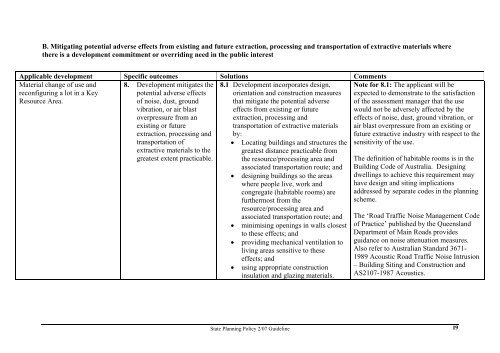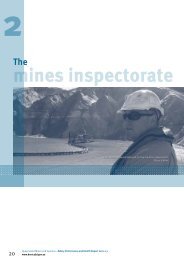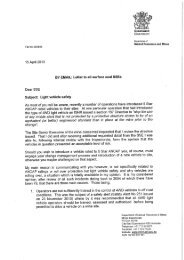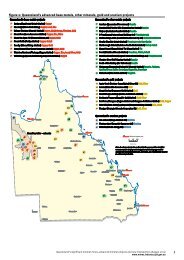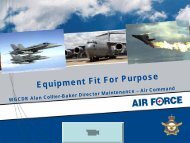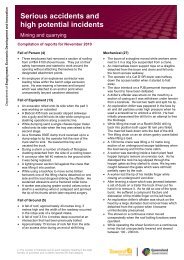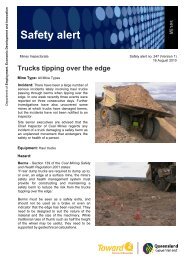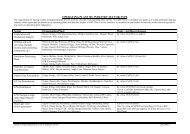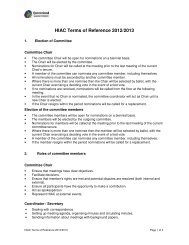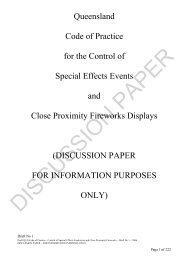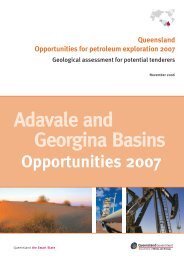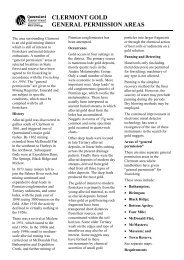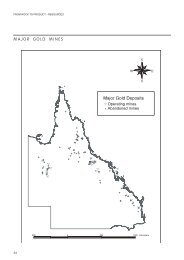State Planning Policy 2/07 Guideline - Queensland Mining and Safety
State Planning Policy 2/07 Guideline - Queensland Mining and Safety
State Planning Policy 2/07 Guideline - Queensland Mining and Safety
You also want an ePaper? Increase the reach of your titles
YUMPU automatically turns print PDFs into web optimized ePapers that Google loves.
B. Mitigating potential adverse effects from existing <strong>and</strong> future extraction, processing <strong>and</strong> transportation of extractive materials where<br />
there is a development commitment or overriding need in the public interest<br />
Applicable development Specific outcomes Solutions Comments<br />
Material change of use <strong>and</strong><br />
reconfiguring a lot in a Key<br />
Resource Area.<br />
8. Development mitigates the<br />
potential adverse effects<br />
of noise, dust, ground<br />
vibration, or air blast<br />
overpressure from an<br />
existing or future<br />
extraction, processing <strong>and</strong><br />
transportation of<br />
extractive materials to the<br />
greatest extent practicable.<br />
8.1 Development incorporates design,<br />
orientation <strong>and</strong> construction measures<br />
that mitigate the potential adverse<br />
effects from existing or future<br />
extraction, processing <strong>and</strong><br />
transportation of extractive materials<br />
by:<br />
• Locating buildings <strong>and</strong> structures the<br />
greatest distance practicable from<br />
the resource/processing area <strong>and</strong><br />
associated transportation route; <strong>and</strong><br />
• designing buildings so the areas<br />
where people live, work <strong>and</strong><br />
congregate (habitable rooms) are<br />
furthermost from the<br />
resource/processing area <strong>and</strong><br />
associated transportation route; <strong>and</strong><br />
• minimising openings in walls closest<br />
to these effects; <strong>and</strong><br />
• providing mechanical ventilation to<br />
living areas sensitive to these<br />
effects; <strong>and</strong><br />
• using appropriate construction<br />
insulation <strong>and</strong> glazing materials.<br />
<strong>State</strong> <strong>Planning</strong> <strong>Policy</strong> 2/<strong>07</strong> <strong>Guideline</strong><br />
Note for 8.1: The applicant will be<br />
expected to demonstrate to the satisfaction<br />
of the assessment manager that the use<br />
would not be adversely affected by the<br />
effects of noise, dust, ground vibration, or<br />
air blast overpressure from an existing or<br />
future extractive industry with respect to the<br />
sensitivity of the use.<br />
The definition of habitable rooms is in the<br />
Building Code of Australia. Designing<br />
dwellings to achieve this requirement may<br />
have design <strong>and</strong> siting implications<br />
addressed by separate codes in the planning<br />
scheme.<br />
The ‘Road Traffic Noise Management Code<br />
of Practice’ published by the <strong>Queensl<strong>and</strong></strong><br />
Department of Main Roads provides<br />
guidance on noise attenuation measures.<br />
Also refer to Australian St<strong>and</strong>ard 3671-<br />
1989 Acoustic Road Traffic Noise Intrusion<br />
– Building Siting <strong>and</strong> Construction <strong>and</strong><br />
AS21<strong>07</strong>-1987 Acoustics.<br />
19


